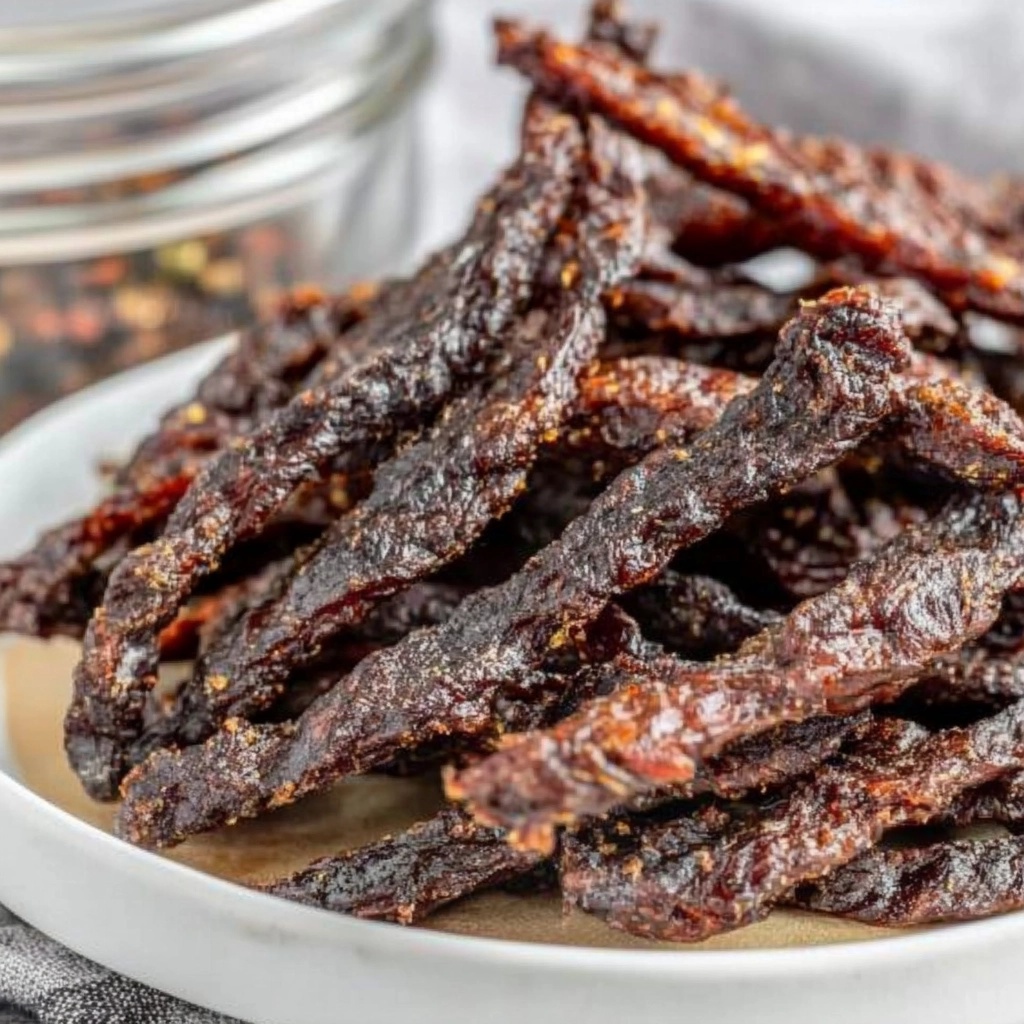 Pin it
Pin it
This tender, flavorful air fryer beef jerky has transformed my snack game completely. Traditional jerky-making methods take days, but this recipe delivers the same satisfying chew and rich flavor in just hours without any preservatives or special equipment beyond your air fryer.
I discovered this technique during a camping trip preparation weekend and have been perfecting it ever since. My teenage son now requests a fresh batch weekly for his sports practices, claiming it gives him "protein power" during games.
Ingredients
- Beef sirloin tip steak: The ideal cut for homemade jerky with the perfect balance of lean meat and flavor. Look for pieces with minimal fat marbling for best results.
- Low-sodium soy sauce: Provides the savory umami foundation without making the jerky too salty. Using low-sodium allows you better control of the final flavor.
- Worcestershire sauce: Adds complexity with its tangy, slightly sweet profile. The fermented anchovy undertones enhance the meaty flavor.
- Brown sugar: Creates perfect caramelization and balances the saltiness. Dark brown sugar works best for deeper molasses notes.
- Garlic powder: Infuses consistent garlic flavor throughout each piece. Fresh garlic can burn during the drying process.
- Onion powder: Adds subtle sweetness and depth. Always check freshness as this spice loses potency quickly.
- Black pepper: Provides classic jerky heat that builds gradually. Freshly ground delivers the most aromatic punch.
- Red pepper flakes: Contributes pleasant heat that intensifies during drying. Adjust quantity to your spice preference.
Step-by-Step Instructions
- Partial Freezing:
- Place beef sirloin in freezer for about 30 minutes until firm but not completely frozen. This crucial step creates the perfect firmness for achieving consistent thin slices. The slight crystallization of the meat fibers makes your knife glide through more predictably. Take care not to freeze solid as this makes slicing nearly impossible.
- Precision Slicing:
- Cut the semi-frozen beef against the grain into quarter-inch thick strips. The direction of your cut directly impacts the tenderness of your final jerky. Look carefully at the meat to identify the muscle fibers running in parallel lines, then position your knife perpendicular to those lines. Keep your knife sharp and maintain steady pressure for consistent thickness.
- Marinade Development:
- Whisk together soy sauce, Worcestershire sauce, brown sugar, and all spices until sugar completely dissolves. The full dissolution of sugar is essential for even flavor distribution. Take time with this process, whisking for at least one full minute. The marinade should appear glossy and have a consistency slightly thicker than plain soy sauce.
- Thorough Marination:
- Submerge beef strips completely in marinade and refrigerate for at least 4 hours, preferably overnight. The longer marination time allows the salt and flavors to penetrate deeply into the meat fibers. Occasionally remix the container to ensure even exposure. The meat will gradually darken as it absorbs the marinade compounds.
- Proper Drying Preparation:
- Pat marinated strips with paper towels to remove excess moisture before arranging in air fryer. Excess surface moisture extends drying time dramatically and can lead to steaming rather than proper drying. Press firmly but gently to avoid squeezing out the absorbed flavors.
- Air Fryer Arrangement:
- Place beef strips in a single layer with small gaps between pieces to allow air circulation. Overcrowding is the most common mistake that leads to uneven drying. If your air fryer has multiple racks, rotate their positions halfway through cooking for the most consistent results across all pieces.
- Precision Drying:
- Cook at 180°F for 2 to 2.5 hours, checking and flipping halfway through. The jerky is finished when it bends without breaking but has no visible moisture when flexed. The texture transformation happens gradually, with the edges typically drying faster than the centers. Touch testing is more reliable than simply timing.
This recipe transformed my relationship with beef jerky completely. The Worcestershire sauce is my secret weapon ingredient here. My grandfather used to make jerky in a smoker that took nearly three days, and he was genuinely impressed when I brought him a batch of this air fryer version during our last fishing trip.
Storage Solutions
Air fryer beef jerky maintains its quality best when stored properly in airtight containers after completely cooling. Mason jars with tight seals work exceptionally well, as do vacuum-sealed bags if you own a vacuum sealer. For extended storage beyond two weeks, refrigeration extends shelf life to about one month. The refrigerator environment slows oxidation that can make the fat in the jerky turn rancid. Freezing is also an excellent option, extending preservation for up to six months without significant texture changes. Just thaw in the refrigerator overnight before enjoying.
Flavor Variations
The basic marinade provided serves as an excellent foundation, but countless variations can transform your jerky experience. For a teriyaki version, increase the brown sugar to 4 tablespoons and add 1 tablespoon of freshly grated ginger. Spicy lovers can double the red pepper flakes and add a teaspoon of cayenne for serious heat that intensifies during the drying process. Experimenting with liquid smoke creates a traditional smokehouse flavor without special equipment. My personal favorite variation incorporates 2 tablespoons of pineapple juice for a subtle sweetness that complements the savory profile perfectly.
Choosing The Right Meat
While this recipe calls for sirloin tip, several alternative cuts work beautifully for homemade jerky. Eye of round produces exceptionally lean results with minimal waste. Top round offers excellent value with a good meat-to-fat ratio. Flank steak provides intense beef flavor but requires more trimming of surface fat. Regardless of cut, success depends on removing visible fat, which can turn rancid during storage. When purchasing beef specifically for jerky, request that your butcher slice it thinly against the grain to save preparation time. Most butchers appreciate knowing your intended use and will select appropriate portions from their inventory.
Frequently Asked Questions
- → How thin should the beef be sliced?
The beef should be sliced into ¼-inch thick strips for the ideal texture. Thinner slices may dry out too quickly, while thicker slices may remain tough.
- → Why should I freeze the beef before slicing?
Freezing the beef for about 30 minutes firms it up, making it much easier to slice thinly and evenly. This ensures uniform drying.
- → How long should I marinate the beef?
Marinate the beef for at least 4 hours, but overnight marination is recommended for deeper and more complex flavors.
- → What temperature should I use for the air fryer?
Set the air fryer to 180°F (82°C) to gently dry the beef without overcooking it. This temperature helps retain the rich flavors.
- → How do I know when the jerky is ready?
The jerky is ready when it bends without breaking and no longer feels moist. It should have a deep mahogany color and a concentrated savory aroma.
- → What’s the best way to store beef jerky?
Once cooled, store the beef jerky in an airtight container to maintain its flavor and texture. It can last up to 1-2 weeks at room temperature or longer if refrigerated.
